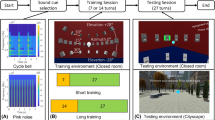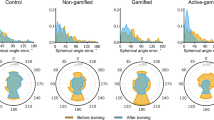Abstract
As the technology improves and their cost decreases, tabletop computers and their inherent ability to promote collaboration amongst users are gaining in popularity. Their use in virtual reality-based applications including virtual training environments and gaming where multi-user interactions are common is poised to grow. However, before tabletop computers become widely accepted, there are many questions with respect to spatial sound production and reception for these devices that need to be addressed. Previous work (Lam et al. in ACM Comput Entertain 12(2):4:1–4:19, 2014) has seen the development of loudspeaker-based amplitude panning spatial sound techniques to spatialize a sound to a position on a plane just above a tabletop computer’s (horizontal) surface. Although it has been established that the localization of these virtual sources is prone to error, there is a lack of ground truth (reference) data with which to compare these earlier results. Here, we present the results of an experiment that measured sound localization of an actual sound source on a horizontal surface, thus providing such ground truth data. This ground truth data were then compared with the results of previous amplitude panning-based spatial sound techniques for tabletop computing displays. Preliminary results reveal that no substantial differences exist between previous amplitude panning results and the ground truth data reported here, indicating that amplitude panning is a viable spatial sound technique for tabletop computing and horizontal displays in general.




Similar content being viewed by others
Explore related subjects
Discover the latest articles and news from researchers in related subjects, suggested using machine learning.References
Anatomage Inc. (2015) Anatomage table virtual dissection. www.anatomage.com. Accessed on 9 July 2015
Alais D, Burr D (2004) The ventriloquist effect results from near-optimal bimodal integration. Curr Biol 14(6):257–262
Algazi VR, Duda RO (2011) Headphone-based spatial sound. IEEE Signal Proc Mag 28(1):33–42
Antani L, Chandak A, Savioja L, Manocha D (2012) Interactive sound propagation using compact acoustic transfer operators. ACM Trans Graph 31(1):1–12
Blauert J (1996) The psychophysics of human sound localization (revised ed). MIT Press, Cambridge
Bortolaso C, Graham TCN, Scott SD, Oskamp M, Brown D, Porter L (2014) From personal computers to collaborative digital tabletops to support simulation based-training. In: Proceedings of 19th international command and control research and technology symposium, Alexandria, VA, USA, pp 37–45
Chowning J (1971) The simulation of moving sound sources. J Audio Eng Soc 19(1):2–6
Cohen M (2010) Under-explored dimensions in spatial sound. In: Proceedings of 9th ACM SIGGRAPH conference on virtual-reality continuum and its applications in industry, Seoul, Korea, pp 95–102
Cohen M, Wenzel E (1995) The design of multidimensional sound interfaces. In: Barfield W, Furness T (eds) Virtual environments and advanced interface design. Oxford University Press Inc, New York, pp 291–346
Dubrowski A, Kapralos B, Jenkin M, Kanev K (2015) Interprofessional critical care training: interactive virtual learning environments and simulations. In: Proceedings of 6th international conference on information, intelligence, systems and applications, Corfu, Greece
Gardner W (1998) 3-D audio using loudspeakers. Kluwer Academic Publishers, Norwell
Han JY (2005) Low-cost multi-touch sensing through frustrated total internal reflection. In: Proceedings of 18th ACM symposium on user interface software and technology, Seattle, WA, USA, pp 235–238
Kapralos B, Jenkin M, Milios E (2008) Virtual audio systems. Presence Teleoper Virtual 17(6):524–549
Kruger R, Carpendale S, Scott SD, Greenberg S (2004) Roles of orientation in tabletop collaboration: comprehension, coordination and communication. Comput Support Coop Work 13(5–6):501–537
Lam J, Kapralos B, Collins K, Hogue A, Kanev K, Jenkin M (2014) Sound localization on table-top computers: a comparison of two amplitude panning methods. ACM Comput Entertain 12(2):4:1–4:19
Makino H, Ishii I, Nakashizuka M (1996) Development of navigation system for the blind using GPS and mobile phone communication. In: Proceedings of 18th annual meeting of the IEEE engineering in medicine and biology society, Amsterdam, The Netherlands, pp 506–507
Nordahl R, Nilsson NC (2014) The sound of being there: presence and interactive audio in immersive virtual reality. In: Collins K, Kapralos B, Tessler H (eds) The Oxford handbook of interactive audio. Oxford University Press, New York, pp 213–233
Ohta Y, Obata K (2007) A method for estimating the direction of sound image localization for designing a virtual sound image localization control system. In: Proceedings of 123rd convention of the audio engineering society, New York, NY, USA, Preprint: 7230
Parise CV, Knorre K, Ernst MO (2014) Natural auditory scene statistics shapes human spatial hearing. Proc Nat Acad Sci 111(16):6104–6108
Perrott DR, Saberi K (1990) Minimum audible angle thresholds for sources varying in both elevation and azimuth. J Acoust Soc Am 87(4):1728–1731
Pulkki V (1997) Virtual sound source positioning using vector base amplitude panning. J Audio Eng Soc 45(6):456–466
Pulkki V (2001a) Localization of amplitude-panned virtual sources I: stereophonic panning. J Audio Eng Soc 49(9):739–751
Pulkki V (2001b) Spatial sound generation and perception by amplitude panning techniques (Unpublished doctoral dissertation). Department of Electrical and Communications Engineering, Helsinki University of Technology, Helsinki, Finland
Pulkki V, Huopaniemi J, Huotilainen T, Karjalainen M (1996) DSP approach to multichannel audio In: Proceedings of international computer music conference, Clear Water Bay, Hong-Kong, pp 93–96
Sasamoto Y, Cohen M, Villegas J (2013) Controlling spatial sound with table-top interface. In: Proceedings of international joint conference on awareness science and technology and ubi-media computing, Aizuwakamatsu, Japan, pp 713–718
Scott SD, Carpendale S (2010) Theory of tabletop territoriality. In: Muller-Tomfelde C (ed) Tabletops—horizontal interactive displays. Springer, London, pp 375–406
Sodnik J, Tomazic S,Grasset R, Duenser A, Billinghurst M (2006) Spatial sound localization in an augmented reality environment. In: Proceedings of 2000 international conference on auditory display, Sydney, Australia, pp 1–8
Väljamäe A (2005) Self-motion and presence in the perceptual optimization of a multisensory virtual reality environment (Tech. Rep. No. R037/2005). Department of Signals and Systems, Division of Communication Systems, Chalmers University of Technology, Sweden
Wallace JR, Scott SD, Stutz T, Enns T, Inkpen KM (2009) Investigating teamwork and taskwork in single and multi-display groupware systems. Personal and ubiquitous computing: special issue on interaction with coupled and public displays 13(8):569–581
Zhou ZY, Cheok A, Qiu Y, Yang X (2007) The role of 3-D sound in human reaction and performance in augmented reality environments. IEEE Trans Syst Man Cybern 37(2):262–272
Acknowledgments
Funding to support this work has been provided by the Research Institute of Electronics, Shizuoka University, in the form of a Cooperative Research Projects Grant, the Social Science and Humanities Research Council of Canada, and the Natural Sciences and Engineering Research Council of Canada.
Author information
Authors and Affiliations
Corresponding author
Rights and permissions
About this article
Cite this article
Lam, J., Kapralos, B., Kanev, K. et al. Sound localization on a horizontal surface: virtual and real sound source localization. Virtual Reality 19, 213–222 (2015). https://doi.org/10.1007/s10055-015-0268-2
Received:
Accepted:
Published:
Issue Date:
DOI: https://doi.org/10.1007/s10055-015-0268-2




